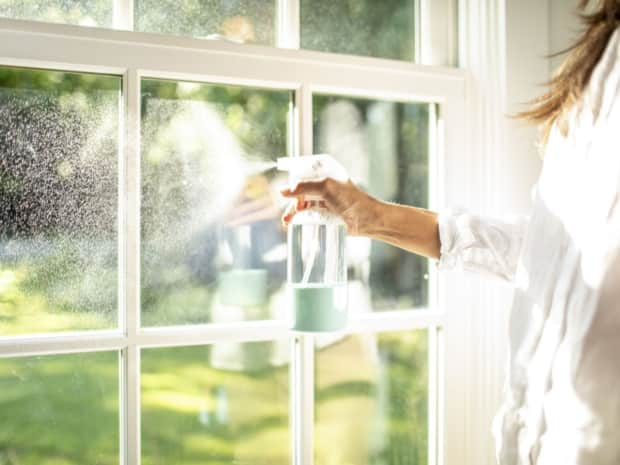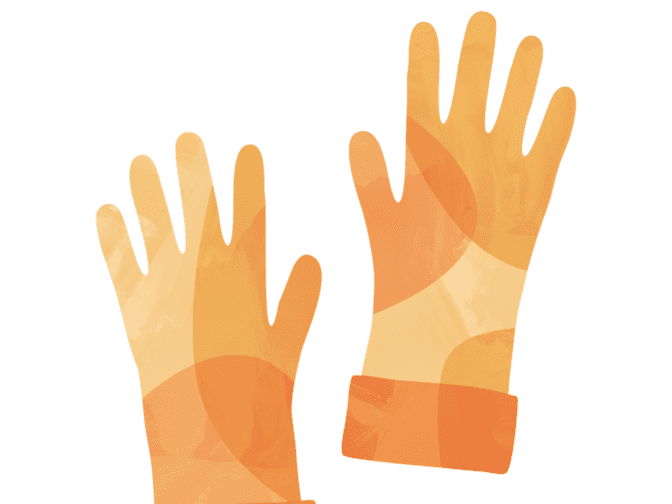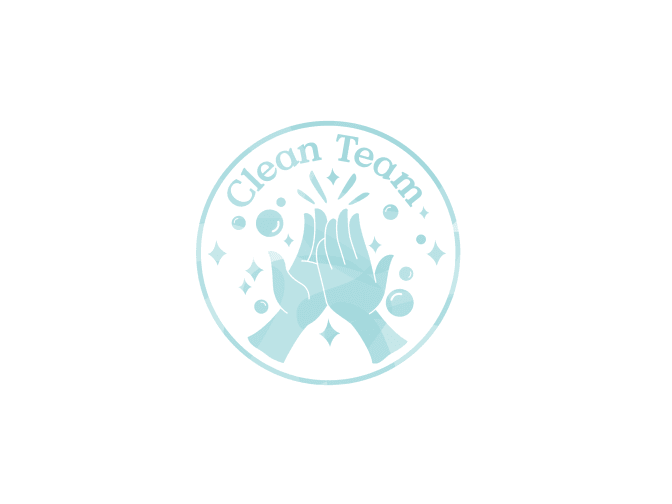
How do you actually clean grout?
Nothing dirties up a space quite like grimy grout, so get it back to gleaming — naturally — with our easy tips and tricks.
Read More


Last Updated: April 15, 2021
Say goodbye to yucky glue and sticker residue when you learn how to get sticker residue of any surface using natural products you have at home.
When you peel off a sticker and none of the sticky stuff comes up with it, fear not: You can easily clean sticker residue and other adhesive off virtually any surface of your home using safe ingredients from the cupboard.
Next time you get in a sticky situation, don’t panic. It’s possible to get sticker residue off virtually any surface in your home — including the jacket you slapped a nametag on and couldn’t get off. Fortunately, cleaning most types of adhesives off the surfaces in your home is pretty easy with these simple solutions that use natural and safe items you probably already have in your cabinets.
From natural household to personal care, everything at Grove is healthier for you and the planet — and works! We recommend monthly shipments and product refills that you can edit or move at any time. No monthly fees or commitments required.
Price tags are one of the worst culprits for sticker residue — especially on items you buy at garage sales, thrift stores, or the dollar store. Ideally, price tags on items you buy will slip right off and take the glue with it. But sometimes, much to your dismay, the price tag will leave behind sticky stuff that won’t come off with the usual thumb-rubbing and fingernail-scraping.
The stickers your kids plaster over every imaginable surface in the house may also be hard to remove if the sticker book manufacturer is staffed by sadists.
When you peel off a sticker and the residue stays behind, it will attract dirt, which will make it a sticky, dirty mess. It’s best to remove the adhesive ASAP — and, here, we’ll show you how to do it.
Before you tackle any sticky surface, you’ll need to have the right tools on hand.

We struggle to understand why some stores slap impossible-to-remove price stickers on their glass items in this age of science that has given us a huge variety of non-stick adhesives. But perhaps the stickiest, most stubborn residue on Earth is the gunk left on glass jars when you try to remove the label so you can use them for vases or food storage.
The adhesive left behind only spreads when you try to loosen it with hot water, and scrubbing it with a cloth only serves to distribute the glue over more of the surface and collect fibers from the cloth. If you think your only hope is a very sharp razor blade — which may scratch the glass — try this instead:
Step 1: Saturate the adhesive with rubbing alcohol, and let it sit for a few minutes.
Step 2: Use a microfiber cloth to gently rub at the sticker residue.
Step 3: If needed, add more rubbing alcohol and repeat the process until the residue is gone.
GROVE TIP
If the glue you’re trying to remove isn’t having it, try a spray lubricant designed to get rid of squeaks on hinges. Spray it on the glue, let it sit for a few minutes, then gently rub with a microfiber cloth.
Toys, home decor, and other plastic surfaces hold onto sticker residue with an iron grip. This safe and natural DIY adhesive remover will remove sticker and glue residue from plastic surfaces without damaging them.
Step 1: Combine two tablespoons of baking soda with one tablespoon of water and two or three drops of lemon or eucalyptus essential oil.
Step 2: Use a rag or a soft brush, such as an old toothbrush, to rub the paste into the residue to loosen and remove.
Step 3: Repeat until the adhesive is gone.
What do you do when you look down to find sticker residue on your wood floors or furniture? Raise your glass to this simple solution: Vodka makes a great substitute for rubbing alcohol and safely removes many types of adhesives from wood surfaces without destroying the finish or color.
Step 1: Dip part of a microfiber cloth into a bit of vodka (or rubbing alcohol).
Step 2: Dab at the residue or glue on the wood surface.
Step 3: Repeat until the spot is gone.
Rubber surfaces are a little more temperamental than others about holding onto sticker residue, but this handy trick will make it go away.
Step 1: Create a toothpaste-like consistency with baking soda and water.
Step 2: Using an old toothbrush or a soft brush, rub the paste onto the residue.
Step 3: Repeat until the spot is gone.
Adhesive on clothing is tricky, because it almost becomes one with the fibers. But, before you toss an item in the wash and hope for the best, do this:
Step 1: Heat up some distilled white vinegar in the microwave in a small bowl.
Step 2: Dip a standard sponge into the vinegar, and squeeze it over the stain. Give the vinegar time to absorb into the fibers to loosen up the adhesive.
Step 3: Use a plastic adhesive scraper or the side of an old gift card to gently lift the adhesive.
Step 4: Pre-treat the spot with laundry detergent — gently rub it in with your fingertips. Wash the item according to the care instructions on the garment.
GROVE TIP
To get super glue out of clothes, use acetone nail polish which will break down glue. Do not use acetone if the fiber content of the cloth contains acetate – it will melt the fibers and ruin your garment. Test the acetone on the inside of the hem first.

Ready to tackle the dirtiest spots in your home? Grove Collaborative has you covered with Clean Team. Each week, we’ll do a deep dive into how to clean a different place or item in your home. No spot is too small — and we’ll tell you how to conquer them all, naturally.

Nothing dirties up a space quite like grimy grout, so get it back to gleaming — naturally — with our easy tips and tricks.

Have you bypassed these overlooked things in your home. If so, we've got tips on how to clean them right now.

Love seat looking less-than-lovely? Here’s the right way to clean and maintain your couches and upholstery.

Here’s how to clean your glass stove top quickly and efficiently using items you already have on hand.